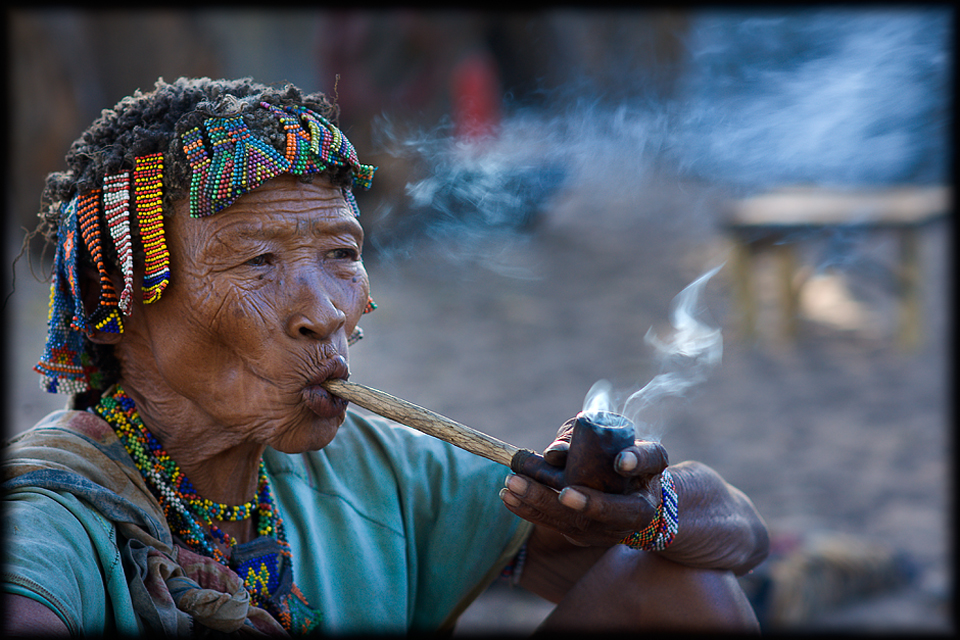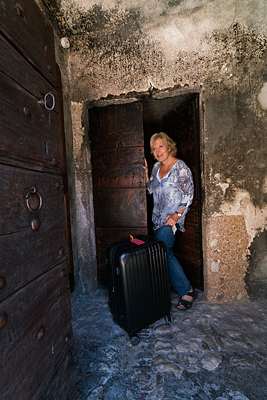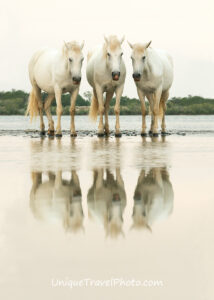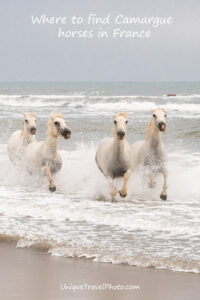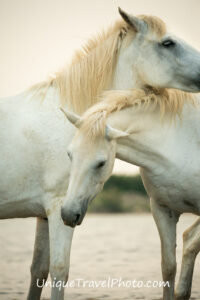
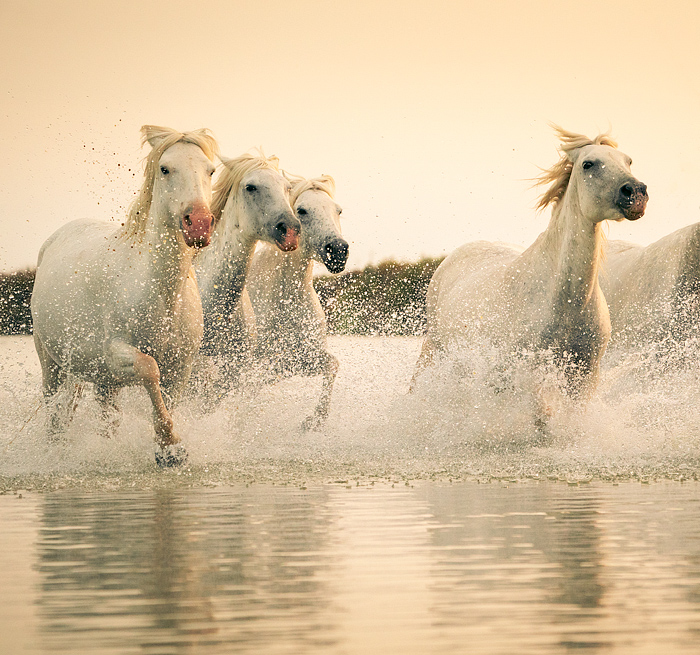 Camargue horses have a wild, untamed beauty. Especially when running through water.
Camargue horses have a wild, untamed beauty. Especially when running through water.
Galloping in unison, staying close together in small groups, these spirited animals look joyful splashing across marshes or sea coasts. Manes flying, silky blond, dancing in the wind. Moving freely. Gracefully. And harmoniously in the nature that surrounds them.

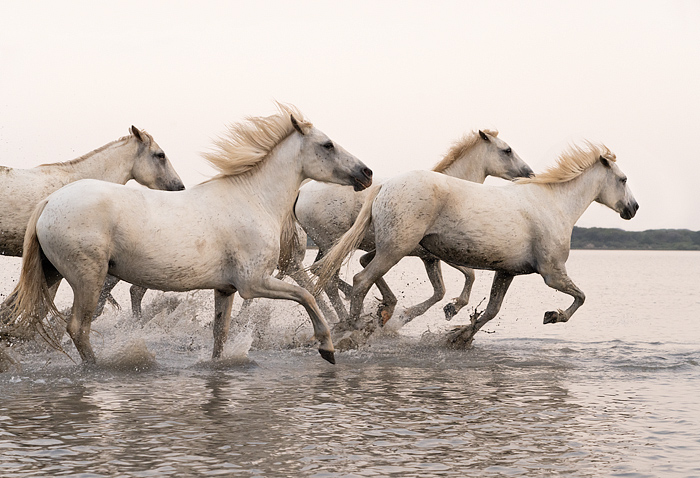
These stunning white horses have become the iconic symbol of the Camargue. They roam semi-freely within the vast land of the Rhône River delta, stretching south of Arles to the Mediterranean Sea.

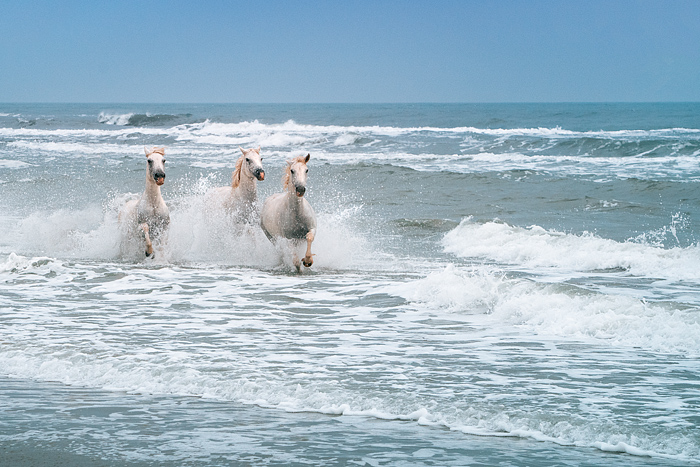
This rare ancient breed is unique to this region alone, where they’ve thrived for centuries. Their origin is mysterious. But archeological evidence suggests that the Camargue horse descended from the Stone Age Solutré horse, which humans hunted at that time. This radically changed 5,000 years ago when the horses became semi-domesticated and respected. Both Julias Caesar and Napoleon revered this breed, and used them in their armies. Today the French government protects Camargue horses and uses a stud book to record every birth to preserve the breed’s standards and lineage.
Characteristics
Camargue horses are intelligent, docile and good-natured. Smaller in size than other breeds–about 13 or 14 hands tall–their compact body is muscular and hearty. They have flat hooves to withstand moisture in the marshes and to navigate boggy grounds, and don’t need to wear shoes.

.jpg)
Known for being resilient, they’ve adapted to their harsh environment. All are born in the wild, spend their days under open skies and forage on natural vegetation. They can withstand heat, cold, strong mistral winds and feed not only on grasses, tender roots and herbs but also salty reeds and tough gooseroot in the marshes. Camargue horses are also the only breed in the world that can graze underwater.

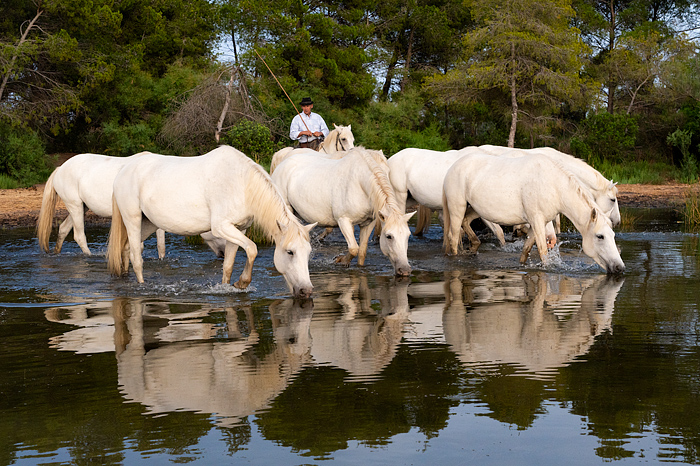
Their striking white color develops over time. Foals are born brown or bay (brown with a black mane, tail or legs).

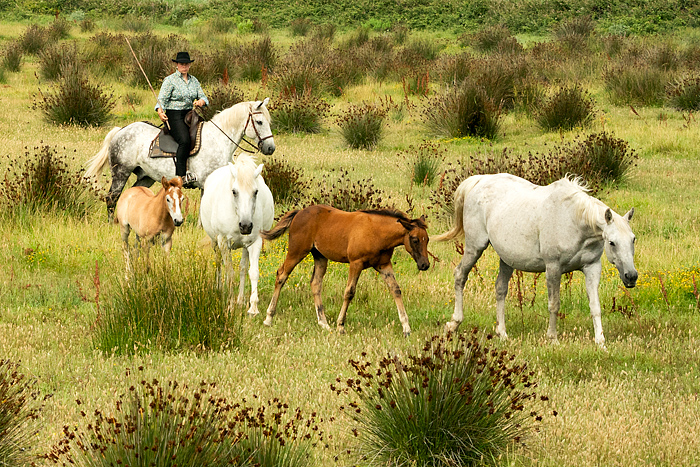
Beginning around 4 years of age, they turn grayish-white or white and may have yellowish or cream-colored silky manes. These beautiful horses can live up to 45 years.
Gardians of Camargue Horses
There are still small herds of wild horses that exist scattered across the Camargue, all protected by the National Park. But most horses roam freely within the boundary of expansive private ranches, called manades. Gardians select a number of stallions to ride, and to use in tourism for horseback riding, but the majority of Camargue horses are never ridden.
Gardians are French cowboys & cowgirls who passionately devote their lives to being caretakers of these Camargue horses and Camargue bulls. They ensure the purity of the breed and protect the semi-feral herds.

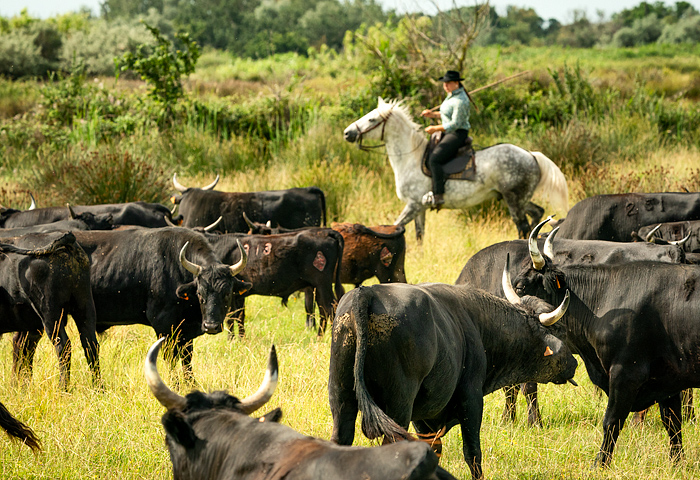
Their work consists of herding large herds of black bulls. Mounted on chosen stallions, Gardians ride one-handed holding the reins very close to the neck. They carry a long wooden pole, called a trident, to drive the bulls. Hand-forged iron basket stirrups provide stability and protect feet from aggressive bulls.
According to legend, Roman god Neptune emerged from the sea with a Camargue horse. This horse was given to a bull breeder to help him catch black bulls from then on.
In return, the Camargue horse was granted freedom forever. That is why Gardians carry a trident to this day.

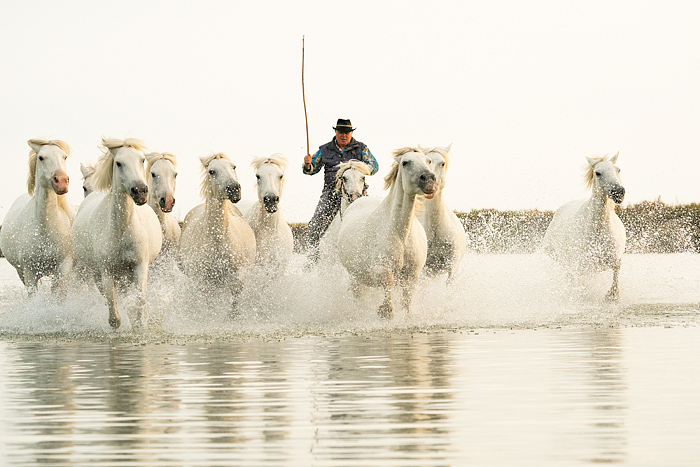
Camargue horses are excellent at herding and separating bulls. They’re sure-footed, agile at turning quickly, fast and fearless of the bulls, making them perfect companions for the gardians who ride them. With wide flat hooves, they can navigate through lagoons, mud and challenging terrain quickly in hot pursuit of the bulls.
Gardians have a special bond with their horses and are experts at using whistles and calls to communicate with them.

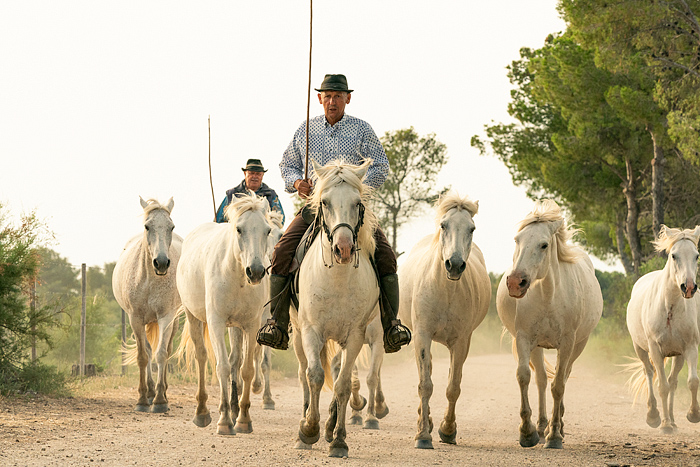
In addition to managing livestock, they also ride them in festivals where horses are celebrated and included in important cultural events. Their colorful print shirts are symbolic of original shirts sewn together with various fabric scraps.

.jpg)
Beautiful and alluring, but elusive
Twenty years ago I visited the Camargue during a photo workshop based in Ansouis, Provence. My instructor drove to a remote salt pan south of Arles and asked me to describe the place in one word. Vast immediately sprang to mind. Flat, baked earth stretched out all around me, seeminly void of any life. No plants. No birds. Just dry, cracked mud. And sandy dirt. With a few random pink flamingo feathers. This was the Camargue? Where were all the flamingos? The horses? I remember feeling very disappointed on the drive back to the village. I had secretly expected to see those beautiful iconic white horses on my one and only visit to this wilderness.
Naive, I know.
The horses are most certainly here. But you need to know where to go!
Where to find Camargue Horses?
Driving around the Camargue
This is the worst idea for dependable sightings. You may get lucky seeing a herd in a field as you drive around the rural roads outside Saints-de-la-Maries, but chances are good that the horses will be far away with heads down, grazing.
Manades
Several manade ranches located between Aigues-Mortes and Saints-de-la-Maries offer tours to individuals and small groups. Official website Coeur de Petite Camargue lists options and contact information for six ranches. There are guided tours on foot, towed tractor trailor or 4×4. Group tours showcase the horses in action, sorting the bulls in the fields. In summer, some manades offer evening tours along with dinner and gypsy guitar music or dancing entertainment.

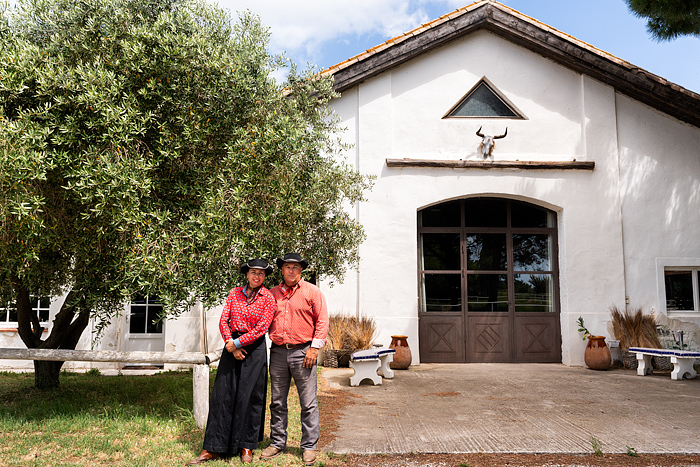
I visited Manade Laurent with the small group Provence tour that I took with my daughter. Normally closed to the public except for pre-arranged groups, they warmly welcomed us in. We spent a delightful morning on their four-generation manade learning about the traditions and lifestyle on a manade, and saw herders in action managing bulls in the field. The outgoing Gardian, Patrick, and his beautiful wife Estelle, were warm and informative about Camargue horses, bull rearing and Camargue racing, which is governed by precise codes and rules. Their love for the horses and their lifestyle was clearly evident.

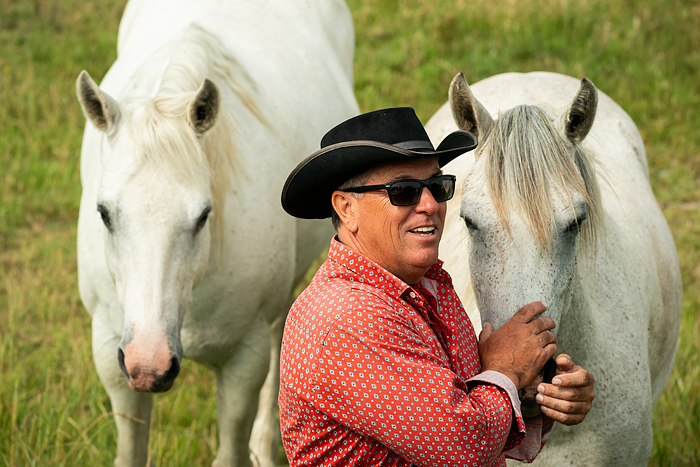
Afterward, in a large room that caters events, we snacked on bull sausage, local cheese and Rosé wine. There were pictures of their celebrated, prized bull Goya and saddles collected from around the world. We learned about the Course Camarguaise, and discovered that Patrick is also the organizer of this important Arles race! (He was surprised to hear that I already had my tickets purchased for the upcoming race– as not many tourists are aware it even exists.)
Horseback riding
Why just admire a Camargue horse from afar when you can actually ride one? Manades, small country inns and organized outfitters offer horseback riding from April to October. Saintes maries de la Mer offers 20 different options. Check out their website www.saintesmaries.com for more information.
I went horseback riding when I stayed at Mas de la Grenouillere, a small horse farm outside the seaside town of Saintes Maries de la Mer.

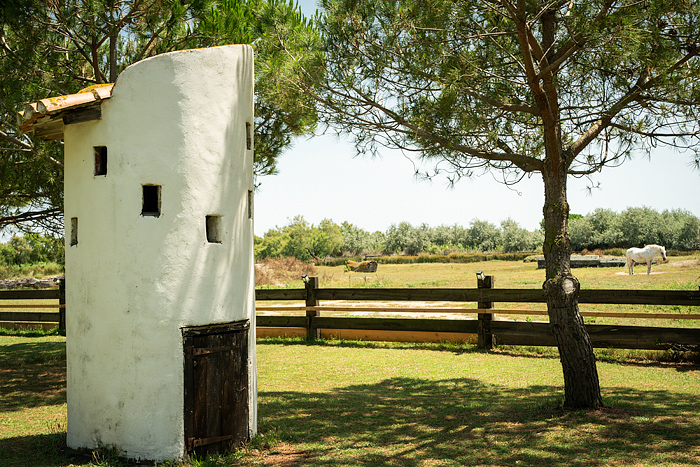
They offer a variety of rides for different levels ranging from 2-6 hours, and also lessons for jumping, dressage and more.

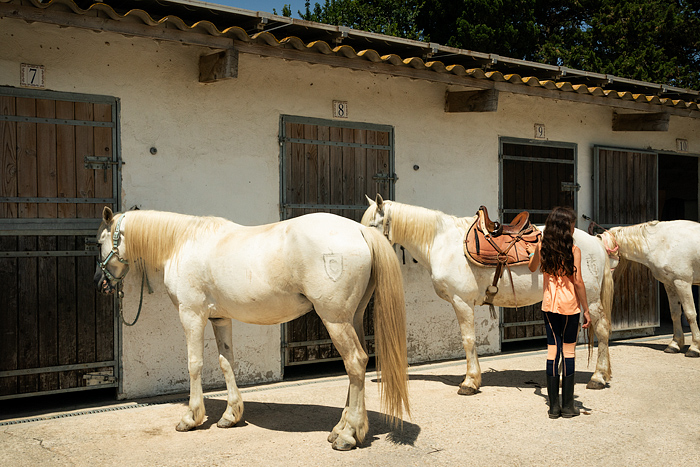
My 3 hour ride began with cleaning dirt off the bottom of the horse’s hooves, then brushing them before saddling. Our small group of five followed our French speaking guide down the sandy street, through tall reeds beside brackish waters where hundreds of mosquitos swarmed, and finally out onto a salt pan under the hot sun. I wasn’t allowed to bring my camera, but I grabbed a few shots before we left. My Camargue horse was gentle, and easy to ride. We walked almost the entire way, except got to trot at the end. I enjoyed seeing the wetlands from a higher perspective atop the horse, and taking part in his care before and after our ride.
Festivals
Saintes-Maries-de-la-Mer
In May, hordes of gypsies make their annual pilgrimage to the seaside town of Saintes Maries de la Mer to honor “Black Sarah” the servant who served the three Mary’s that landed here in 45AD after being lost at sea. This festive time celebrates their faith, culture and traditions and includes Gardians riding Camargue horses through the streets. The Gypsy king and archbishop decked out in elaborate costumes lead a procession mounted on horses carrying Saint Sarah relics from the ancient Notre Dame church to the Mediterranean Sea.
In June, the Village Fair is held. Gardians on Camargue horses parade through the streets along with other horses.
November 11th is the Festival of Abrivado where hundreds of Gardians and a thousand Camargue horses run across the beach at the seaside town of Saintes-Maries-de-la-Mer. This is a great opportunity to see the horses splashing in the shallow waters of the Meditteranean Sea. Afterward, the gardians demonstrate bull herding on horseback in the arena.
Arles
On May 1st, the Festival of the Gardians takes place each year. Organized by the Gardians Brotherhood (established in 1512), bull herders ride their Camargue horses through the small narrow streets of Arles to Église de la Major. Here the riders and horses are blessed in a church service. Afterward, the Gardians demonstrate the agility of their Camargue horses in the 2,000 year old Roman arena while working with the bulls and playing equestrian games.
In July, there are two annual festivities in Arles where you can see Camargue horses. During the Costume de Fete, Gardians ride horses in a procession where 500 females dressed in traditional Arlesian finery, representing their region of Provence, winding through the streets beginning at the Arena and ending at the ancient Theatre ruins. This annual festival which began in 1904 is still going strong.

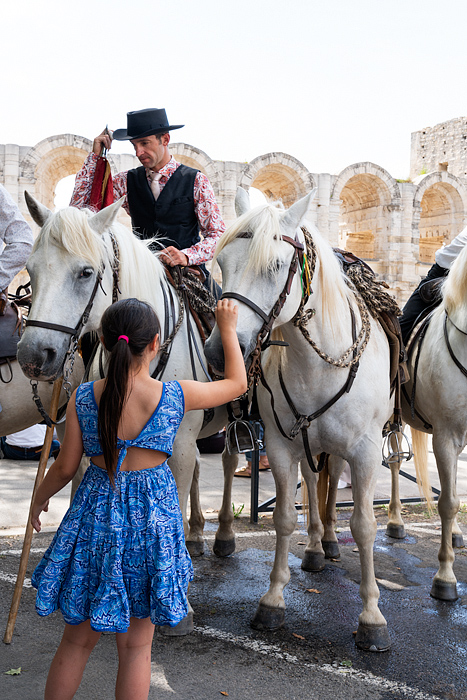
The Course Camarguaise features the most important Camargue bull race of the season. Gardians riding Camargue horses run beside the bulls in the street, herding them and providing a barrier from spectators as they make their way to the Roman Arena.

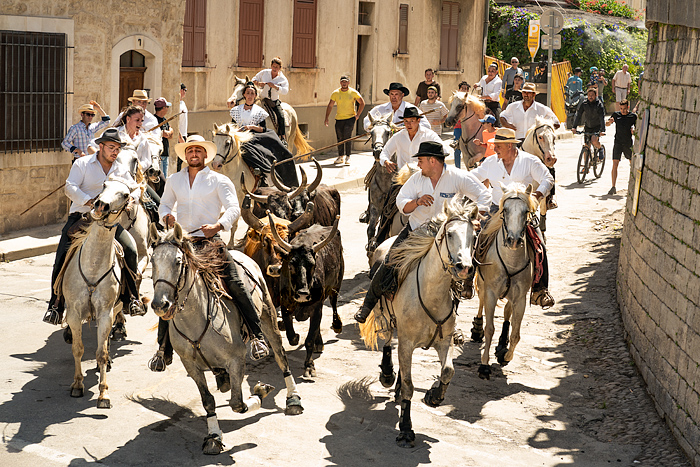
The race begins with a lengthy ceremony featuring Artesian women dancing in traditional costumes and Gardians on horseback parading around the Arena. During the race, Camargue horses are used to herd the bull back into the pen after his 15 minute spotlight. Bulls are not killed or injured in these races. Men, called razeteurs, approach the bull on foot attempting to steal ribbons from their horns. It is a chance for both bulls and the men to show their agility, skill and speed. The razeteur who collects the most ribbons, and the bull who best evades the razeteurs are the winners along with the manade that bred it.
Photo shoots
If you want that classic shot of Camargue horses running through the water or standing in shallow lagoons nuzzling each other affectionately, you simply must join a photo shoot. You’ll get close to the action and capture them in the best light. There are 2 local photographers who offer private and small group photo shoots from spring to autumn.

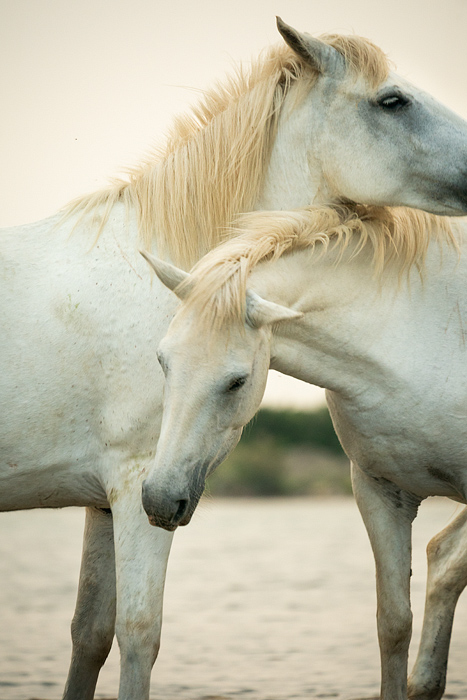
Cécile Domens, based in the Camargue, is a gardian and photographer who offers private and small group shoots of Camargue horses in the marsh, along the ocean coast, and in the salt flats. Capture horses running, stallions sparring, and mares caring for their young foals. Features sunrise or sunset shoots from 1 to 3 days. Her website is cecile-domens-photo.com.
Serge Krouglikoff is a former fashion photographer from London who now resides in the Camargue. He offers private and a variety of group tours lasting 3-8 nights through his website Create-Away.com.

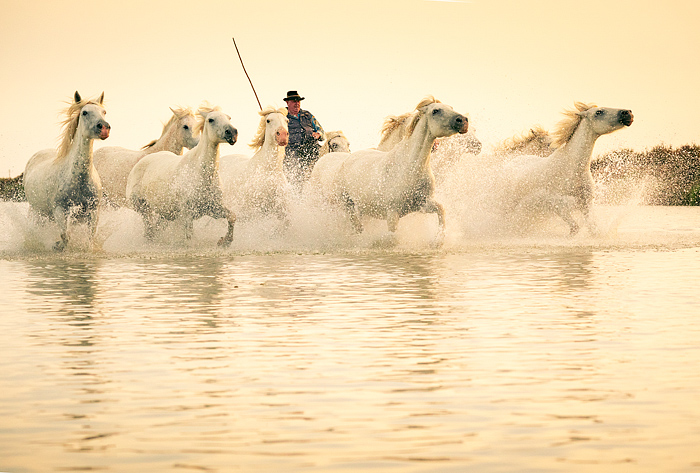
A new 2 hr sunrise shoot on GetYourGuide.com offers the chance to photograph horses running through the marsh for $300. Countless other photographers, worldwide, organize week-long photo workshops for groups that include numerous opportunities to capture these beautiful animals in various settings from marshes, lagoons, and dunes to ocean coasts. Some combine lavender fields and Provencal villages with the horse shoots.
Photo tips:
Composition:
Squat low to shoot at eye level. Emphasize their hooves splashing in water. Shoot into the sun to catch backlit manes and tails flying in the air. Sunrise provides soft pastel light while sunset can be golden and more dramatic. Watch the horizon and keep it straight.
Camera considerations:
Use a camera that has high-speed drive to shoot images in fast sucession. Love my Sony a9 for this reason alone! The original a9 featured the “world’s first blackout-free continuous shooting up to 20 fps” but the newest Sony a9III model captures an astonishing 120 frame per second! Incredible. You’ll never miss a shot. Other camera settings to use include continuous tracking mode, animal eye focus tracking, and of course a fast shutter speed (minimum 1/500). Lens choice: 70-200mm f2.8 or 100-400mm zoom telephoto to isolate the horses and capture the action. And you’ll need a fast memory card. I’ve found this one to be the best and most reliable whenever I travel as it is made for harsh conditions, is waterproof, strong, and has fast writing speed which is excellent for 4K video and fast continuous burst mode shooting.

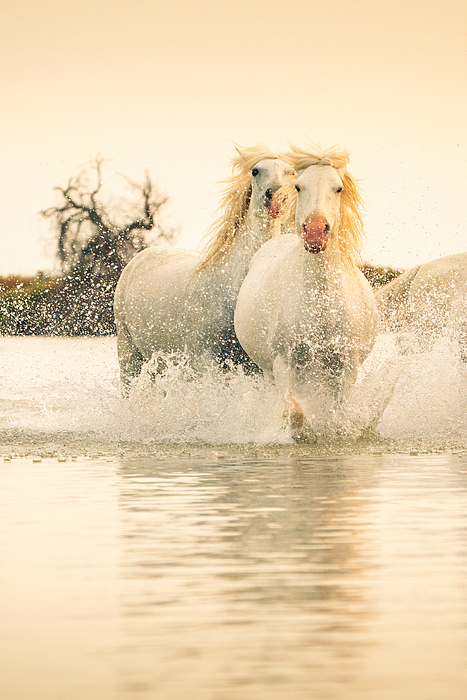
Recommended equipment:
A camera harness comes in very handy on a dedicated photo shoot when you want to bring 2 camera bodies each with a different lens range. Especially if you’ll be standing in water. There is zero place to put down a camera backpack or camera bag. You’ll be walking to the marshes and wading out into the water with your camera in hand. I used this camera harness system which allowed me to keep a camera with a 24-105mm lens safely attached at chest level, freeing up both hands to stabilize my a9 attached with my 100-400mm lens. If I wanted to change cameras, I left the a9 around my neck and simply lifted the other camera off.
Use a lens hood to help protect your lens from water. And tuck a few moist lens wipes in your pocket. You’ll want to clean any water droplets off your lens after the horses gallop past at close range.

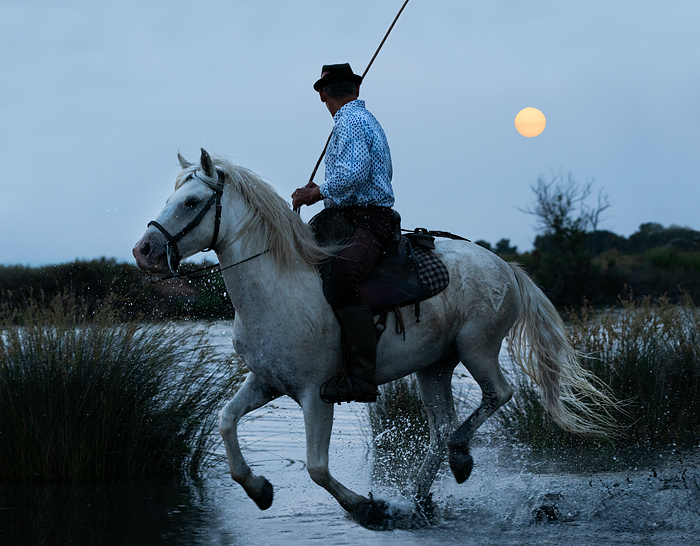
What a difference it makes knowing where to go. Compared to my first trip here, when I saw zero—to seeing so many Camargue horses on this trip to France. Loved the variety of settings too! Hope this guide is helpful in planning your own trip to this remote region so that you too can capture the romance and beauty of these stunning white Camargue horses.
~~~~~~~~~~~~~~~~~~~~~~~~~~~~~~~~~~~~~~~~~~~~~~~~~~~~~~~~~~~~~~~~~~~~~~~~~~~~~~~~~~~~~~~~~
Add a pic to your Pinterest board…


